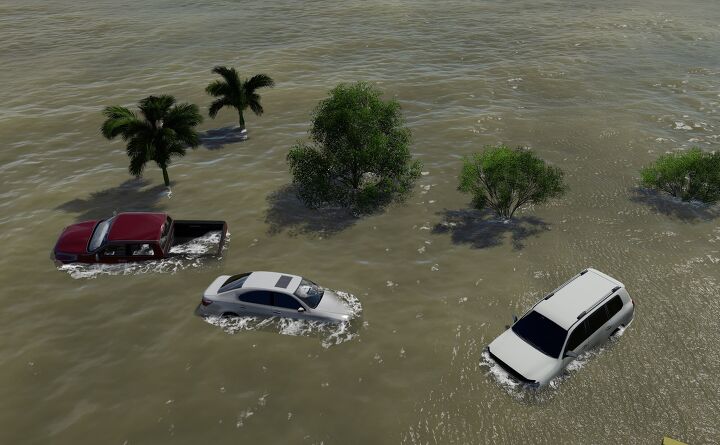While natural disasters are something insurance firms have to deal with on a regular basis, some are so serious that they cause the industry to reassess how they offer coverage. Hurricane Helene, which devastated parts of Florida, North Carolina, South Carolina, Georgia, Virginia, Tennessee and even Kentucky, is looking like one of those events. Estimates have the storm causing upwards of $47.5 billion in losses for property owners. Insurance companies, which are in the business of making money, are going to have to cover some of that — with automobiles being second only to houses.
Early estimates have residents sitting on $20-30 billion of uninsured losses due to the fact that some of the affected states aren’t normally prone to flooding. Much of the damage occurred further inland than would be expected from a hurricane, meaning residents and businesses were less prone to have the applicable coverage.
However, that’s only the tip of the iceberg. Estimates for the total economic losses incurred as a result of the hurricane are expected to be closer to $250 billion. But this includes loss of life (the current death toll is somewhere around 200), work stoppages due to sustained power outages, hospital bills for injured residents/rescuers, lapses in tourism, essential infrastructure that needs to be rebuilt (e.g. roads, bridges, phone lines, power stations, water plants, sewers), and just about anything else you can imagine.
As for cars, there’s likely to be a regional deficit for the next several months. Considering that we have examples of entire towns being washed away by flooding, there are plenty of automotive dealerships that didn’t stand a chance. There will also be more people in need of replacement vehicles, spiking demand even further. This may be a good time to remind everyone to triple check the history of any used vehicles they’re considering purchasing, because a bunch of flood-damaged vehicles are about to find their way onto the secondhand market.
And things may soon get much worse. FEMA has announced $210 million in federal assistance for Hurricane Helene, noting that some of that money may likewise be used for Hurricane Milton — which is presently approaching the Gulf Coast.
With the above in mind, insurance firms are allegedly considering revising how they cover things. At the end of the day, insurers want to maintain juicy profit margins and having to payout for coverage cuts into that. Helene may end up encouraging agencies to increase rates or cut coverage for specific areas. Andrew Hoffman, professor of sustainable enterprise at the University of Michigan, recently spoke with Automotive News to that effect.
“It won't be done based on just one storm,” Hoffman told the outlet. “It'll be based on their sense of whether this storm reflects a growing trend that they need to be alert to.”
From Automotive News:
Hoffman said he would expect to see some changes in insurance coverage as a result of such natural disasters, which would translate directly into how businesses handle their insurance needs.
It could affect auto dealerships, which typically hold a higher level of expensive assets than homeowners, Hoffman said. In dealers' cases, an event such as Helene might cause insurance companies to seek further storm-proofing of a dealership property to protect vehicle inventory.
“We're talking millions of dollars in cars sitting in a car lot,” Hoffman said. “We're also talking [about] the business. Their business is now interrupted. Their revenue stream is gone, and they need to access more product to bring to their customers, who are expecting those cars to be there.”
One item that adds complexity to the matter is the fact that insurance has effectively become a requirement for owning a vehicle. New York became the first state to pass a compulsory automotive insurance law in 1956. Over the next several decades, that became true for the rest of the nation (minus New Hampshire and Virginia, which require drivers to pay out damages if they don’t have insurance). By making automotive insurance a requirement, U.S. customers expect to be covered — otherwise what are they paying all that money for?
But, unless you have comprehensive coverage, which costs significantly more and isn’t mandatory in any state, you’re not going to be reimbursed for water damage. Even then, how the coverage is applied will be conditional between your individual contract, variances between regions, your deductible, and the conditions under which the vehicle was damaged. The bottom line is that if the insurance agency can find ways not to cover the car, they probably won’t. Meanwhile, odds are good that rates are going to increase in general next year as overall coverage shrinks a tad.
That said, it probably won’t be individual policyholders that will be seeing the biggest changes moving forward. Most of the discussions taking place within the insurance industry seem to revolve around commercial policies, with residential contracts being secondary.
For dealers, the hurricane can be viewed as a massive windfall or major disaster. It all depends on the kind of losses they took and whether or not it will be covered. Local residents will need new vehicles regardless and a retailer with untouched inventories will be well positioned. But the same cannot be said for dealerships that had vehicles submerged in floodwaters and are having trouble getting their insurance provider to offer the maximum coverage.
Wards Auto offered an assessment of the overarching situation, noting that there will be a period where surviving dealerships won’t have sufficient inventories to satisfy demand in the impacted states. This will be followed by a stint where vehicles will come in at prices many local residents may not be able to afford. Keep in mind that the average American already cannot afford to buy a new vehicle and many of the areas hit hardest by the storm tended to be poor.
“A lot of the places where there was a lot of destruction, it is people that are lower income,” Todd Caputo, president of Todd Caputo Consulting, told Wards. “They are not going to be buying or replacing their cars with a late model used car or brand-new car. They are going to be looking for cars under $10,000 or even $5,000.”
Those are already hard to come in decent shape in places that weren’t just hit by a natural disaster. Finding one in the states suffering the worst under the storm may soon border on a miracle. However, price increases probably won’t be region locked. Despite the United States approaching a point where swelling vehicle inventories were starting to bring down the valuation of some models, this storm will be pushing things in the opposite direction. The deals will just be worse in areas where people are the most desperate.
Nobody wants to hear that the light at the end of the tunnel is just going to get further away. But that’s likely to be the case. Used vehicles (especially those allocated to areas hit by the hurricane) are probably going to be getting even more expensive this year and insurance rates look poised to increase for 2025. Although, that’s not wholly the fault of Hurricane Helene.
Some of the price increases we’ve seen in recent years are simply the result of manufacturers prioritizing higher-margin vehicles and dealerships knowing they could get away with markups. Meanwhile, the percentage of uninsured drivers in the United States has ballooned since 2019 when it was hovering around 11 percent. Rising costs have been attributed as the largest single factor, with certain states (e.g. New Mexico, Mississippi, Tennessee) now estimated to have over 20 percent of their population driving around without insurance. Sadly, fewer motorists bothering to buy insurance will likewise be used as an excuse to raise rates on those that do.
[Image: Adansijav Official/Shutterstock]
Become a TTAC insider. Get the latest news, features, TTAC takes, and everything else that gets to the truth about cars first by subscribing to our newsletter.
Source: The Truth About Cars

